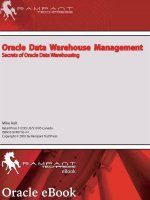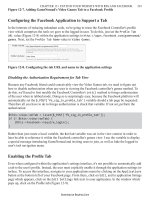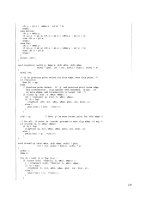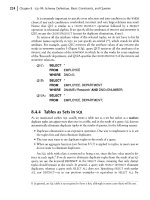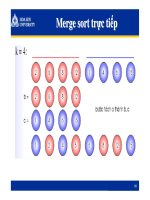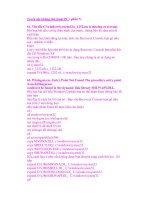Rampant TechPress Oracle Data Warehouse Management PHẦN 7 pdf
Bạn đang xem bản rút gọn của tài liệu. Xem và tải ngay bản đầy đủ của tài liệu tại đây (177.93 KB, 13 trang )
ROBO B
OOKS
M
ONOGRAPH
D
ATA
W
AREHOUSING AND
O
RACLE
8
I
P
AGE
71
In the first example lets do some summary work against the DBA_ views so we
can query about total space, total extents, etc. without having to place the code
into our reports. This will actually be a materialized view based on two example
tables TAB_EXAMPLE1 and TAB_EXAMPLE1 that are based on the underlying
DBA_ views DBA_TABLES and DBA_EXTENTS.
CREATE MATERIALIZED VIEW table_extents
TABLESPACE tools
STORAGE (INITIAL 1M NEXT 1M PCTINCREASE 0)
NOLOGGING
BUILD IMMEDIATE
REFRESH COMPLETE START WITH SYSDATE NEXT SYSDATE+1/24
AS
SELECT
a.owner owner,
a.table_name table_name,
a.tablespace_name tablespace_name,
count(b.owner) extents,
sum(b.bytes) bytes
FROM
tab_example1 a,
tab_example2 b
WHERE
a.owner <>’SYSTEM’
AND a.owner=b.owner
AND a.table_name=b.segment_name
AND b.segment_type=’TABLE’
GROUP BY
a.owner,a.table_name, a.tablespace_name;
What does a materialized view buy us as far as performance? Let’s look at the
explain plans for a query on a regular view and then one on the materialized view
we just created. First create an identical normal view:
CREATE VIEW test_view
AS
SELECT
a.owner owner,
a.table_name table_name,
a.tablespace_name tablespace_name,
count(b.owner) extents,
sum(b.bytes) bytes
FROM
tab_example1 a, tab_example2 b
WHERE
a.owner <>’SYSTEM’
AND a.owner=b.owner
AND a.table_name=b.segment_name
AND b.segment_type=’TABLE’
GROUP BY a.owner,a.table_name, a.tablespace_name;
Now let’s set autotrace on with the explain option and see what happens when
we select against each of these objects.
C
OPYRIGHT
© 2003 R
AMPANT
T
ECH
P
RESS
. A
LL
R
IGHTS
R
ESERVED
.
ROBO B
OOKS
M
ONOGRAPH
D
ATA
W
AREHOUSING AND
O
RACLE
8
I
P
AGE
72
SQL> set autotrace on explain
SQL> select * from test_view
2* where extents>1
OWNER TABLE_NAME TABLESPACE_NAME EXTENTS BYTES
SYS ACCESS$ SYSTEM 8 536576
SYS ARGUMENT$ SYSTEM 10 1191936
SYS COM$ SYSTEM 7 368640
SYS CON$ SYSTEM 3 45056
SYS DEPENDENCY$ SYSTEM 7 352256
SYS ERROR$ SYSTEM 2 24576
SYS EXTENT_TO_OBJECT_TAB SYSTEM 3 45056
SYS EXT_TO_OBJ SYSTEM 4 86016
SYS HIST_HEAD$ SYSTEM 3 45056
SYS IDL_CHAR$ SYSTEM 7 368640
SYS IDL_SB4$ SYSTEM 9 802816
SYS IDL_UB1$ SYSTEM 14 5861376
SYS IDL_UB2$ SYSTEM 13 3915776
SYS OBJ$ SYSTEM 7 352256
SYS OBJAUTH$ SYSTEM 3 45056
SYS PROCEDURE$ SYSTEM 2 24576
SYS SEQ$ SYSTEM 2 24576
SYS SOURCE$ SYSTEM 18 29503488
SYS SYN$ SYSTEM 3 45056
SYS VIEW$ SYSTEM 10 1191936
20 rows selected.
Execution Plan
0 SELECT STATEMENT Optimizer=CHOOSE
1 0 VIEW OF ‘TEST_VIEW’
2 1 FILTER
3 2 SORT (GROUP BY)
4 3 MERGE JOIN
5 4 SORT (JOIN)
6 5 TABLE ACCESS (FULL) OF ‘TAB_EXAMPLE2’
7 4 SORT (JOIN)
8 7 TABLE ACCESS (FULL) OF ‘TAB_EXAMPLE1’
SQL> select * from table_extents
2* where extents>1
C
OPYRIGHT
© 2003 R
AMPANT
T
ECH
P
RESS
. A
LL
R
IGHTS
R
ESERVED
.
ROBO B
OOKS
M
ONOGRAPH
D
ATA
W
AREHOUSING AND
O
RACLE
8
I
P
AGE
73
OWNER TABLE_NAME TABLESPACE_NAME EXTENTS BYTES
SYS ACCESS$ SYSTEM 8 536576
SYS ARGUMENT$ SYSTEM 10 1191936
SYS COM$ SYSTEM 7 368640
SYS CON$ SYSTEM 3 45056
SYS DEPENDENCY$ SYSTEM 7 352256
SYS ERROR$ SYSTEM 2 24576
SYS EXTENT_TO_OBJECT_TAB SYSTEM 3 45056
SYS EXT_TO_OBJ SYSTEM 4 86016
SYS HIST_HEAD$ SYSTEM 3 45056
SYS IDL_CHAR$ SYSTEM 7 368640
SYS IDL_SB4$ SYSTEM 9 802816
SYS IDL_UB1$ SYSTEM 14 5861376
SYS IDL_UB2$ SYSTEM 13 3915776
SYS OBJ$ SYSTEM 7 352256
SYS OBJAUTH$ SYSTEM 3 45056
SYS PROCEDURE$ SYSTEM 2 24576
SYS SEQ$ SYSTEM 2 24576
SYS SOURCE$ SYSTEM 18 29503488
SYS SYN$ SYSTEM 3 45056
SYS VIEW$ SYSTEM 10 1191936
20 rows selected.
Execution Plan
0 SELECT STATEMENT Optimizer=CHOOSE
1 0 TABLE ACCESS (FULL) OF ‘MVIEW_TEST’
As you can see, we get identical results but the second query against the
materialized view only does a single table scan against the materialized view
table, not two table scans against the under lying base tables. The results would
be even more advantageous for a remote snapshot since no network traffic
would be involved. Also notice in the materialized view we are updating once an
hour. While a view will give an instantaneous result (after the view itself is
instantiated) the materialized view will only be as current as its last refresh. The
materialized view can be created such that any commit against the base table
forces a refresh against the materialized view if the materialized view is not an
has no aggregations or includes no joins.
Altering a Materialized View or Snapshot
As with snapshots, a materialized view can have its physical attributes altered,
index parameters changed, its logging and cache parameters changed (look at
the syntax for the command on the included CD-ROM SQL Manual) in addition, a
materialized view can have the ability to allow query re-write enabled or disabled.
Dropping a Materialized View
The command to drop a materialized view or snapshot is rather simple:
C
OPYRIGHT
© 2003 R
AMPANT
T
ECH
P
RESS
. A
LL
R
IGHTS
R
ESERVED
.
ROBO B
OOKS
M
ONOGRAPH
D
ATA
W
AREHOUSING AND
O
RACLE
8
I
P
AGE
74
DROP MATERIALIZED VIEW|SNAPSHOT
[schema.]materialized_view_name|snapshot_name;
Refreshing Materialized Views
Normally a materialized view will be refreshed using the DBMS_JOB queues.
This means that you must have at least one job queue set up and operating,
normally I suggest at least two queues or mre be set up using the
JOB_QUEUE_PROCESSES and JOB_QUEUE_INTERVAL initialization
parameters. These parameters are synonymous with the
SNAPSHOT_QUEUE_PROCESSES and SNAPSHOT_INTERVAL parameters in
prior releases. A third parameter, JOB_QUEUE_KEEP_CONNETIONS forces
the database links opened for remote snapshots or materialized views to be held
open between refreshes.
Materialized views can be refreshed using COMPLETE, FAST, FORCE, ON
DEMAND or ON COMMIT depending on the complexity of the materialized view.
A COMPLETE truncates the materialized view table and reloads it from scratch.
A FAST uses a materialized view log to only update changed rows. If you intend
to use the FAST refresh method, you must create the materialized view log first
and then the materialized view. A FORCE will perform a FAST if possible and a
COMPLETE if required. ON DEMAND uses the DBMS_MVIEW or DBMS_SNAP
packages to complete a refresh and ON COMMIT refreshes a materialized view
or snapshot whenever a commit is executed against the base table (for a simple
materialized view with no joins or aggregations.)
Oracle8i has provided a new package, DBMS_MVIEW which handles refresh
activity on materialized views on demand.
The DBMS_SUMMARY Package in Oracle8i
In order to make the use of DIMENSION and Materialized view objects easier in
Oracle8i, Oracle Corporation has provided the DBMS_SUMMARY package.
However, the package is synonymed to be called DBMS_OLAP when you look
into the data dictionary to find it.
The DBMS_OLAP package is used to maintain summaries. Summaries are also
known as materialized views. The package DBMS_OLAP contains functions and
procedures used to analyze the effectiveness of materialized views and provide
advice as to how to better utilize materialized views. You should be able to call
the procedures and functions inside DBMS_OLAP from other packages.
The DBMS_OLAP package can generate the following errors:
C
OPYRIGHT
© 2003 R
AMPANT
T
ECH
P
RESS
. A
LL
R
IGHTS
R
ESERVED
.
ROBO B
OOKS
M
ONOGRAPH
D
ATA
W
AREHOUSING AND
O
RACLE
8
I
P
AGE
75
Error Description
ORA-30476 PLAN_TABLE does not exist in the user's schema
ORA-30477 The input select_clause is incorrectly specified
ORA-30478 Specified dimension does not exist
ORA-30479 Summary Advisor error\n <QSM message with more
details
QSM-00501 Unable to initialize Summary Advisor environment
QSM-00502 OCI error
QSM-00503 Out of memory
QSM-00504 Internal error
QSM-00505 Syntax error in <parse_entity_name> -
<error_description>
QSM-00506 No fact-tables could be found
QSM-00507 No dimensions could be found
QSM-00508 Statistics missing on tables/columns
QSM-00509 Invalid parameter - <parameter_name>
QSM-00510 Statistics missing on summaries
QSM-00511 Invalid fact-tables specified in fact-filter
QSM-00512 Invalid summaries specified in the retention-list
QSM-00513 One or more of the workload tables is missing
There are numerous procedures and functions that make creation and utilization
of materialized views easier in the DBMS_OLAP package. The actual package is
called DBMS_SUMMARY and the DBMS_OLAP synonym is used to point to
DBMS_SUMMARY. The package is created with the DBMSSUM.SQL script.
CLEANUP_SUMDELTA
The procedure cleanup_delta is an internal use procedure and won't be used by
the DBA.
COMPUTE_AVG
The function COMPUTE_AVG accepts four input variables: fullsum_avg
(NUMBER), fullsum_count(NUMBER), deltasum_avg(NUMBER) and
deltasum_count(NUMBER) and returns a NUMBER value. In this form the
calculation would seem to have little use, you provide it the average value and
the number of measurements along with an average difference from the average
and the number of points different and it calculates an adjusted average for
example:
C
OPYRIGHT
© 2003 R
AMPANT
T
ECH
P
RESS
. A
LL
R
IGHTS
R
ESERVED
.
ROBO B
OOKS
M
ONOGRAPH
D
ATA
W
AREHOUSING AND
O
RACLE
8
I
P
AGE
76
SQL> select dbms_olap.compute_avg(20,5,1,1) from dual;
DBMS_OLAP.COMPUTE_AVG(20,5,1,1)
16.8333333
SQL> select dbms_olap.compute_avg(20,5,0,0) from dual;
DBMS_OLAP.COMPUTE_AVG(20,5,0,0)
20
SQL> select dbms_olap.compute_avg(25,5,5,5) from dual
DBMS_OLAP.COMPUTE_AVG(25,5,5,5)
15
SQL> select dbms_olap.compute_avg(25,5,5,1) from dual
DBMS_OLAP.COMPUTE_AVG(25,5,5,1)
21.6666667
This appears to be an internal use function but those statisticians out there may
find it useful.
COMPUTE_AVG2
The function compute_avg2 accepts four input variables: fullsum_sum (number),
fullsum_count (number), deltasum_sum (number), deltasum_count (number) and
returns a number value. This appears to be a more standard average calculation
in that you give it a sum and a count and it returns an average value. If you also
specify a sum of differences and the count of values differing from average it
produces an adjusted average. For example:
SQL> select dbms_olap.compute_avg2(25,5,5,1) from dual
DBMS_OLAP.COMPUTE_AVG2(25,5,5,1)
5
SQL> select dbms_olap.compute_avg2(25,5,0,0) from dual
DBMS_OLAP.COMPUTE_AVG2(25,5,0,0)
5
SQL> select dbms_olap.compute_avg2(25,5,20,1) from dual
DBMS_OLAP.COMPUTE_AVG2(25,5,20,1)
7.5
SQL> select dbms_olap.compute_avg2(25,5,10,5) from dual
DBMS_OLAP.COMPUTE_AVG2(25,5,10,5)
3.5
C
OPYRIGHT
© 2003 R
AMPANT
T
ECH
P
RESS
. A
LL
R
IGHTS
R
ESERVED
.
ROBO B
OOKS
M
ONOGRAPH
D
ATA
W
AREHOUSING AND
O
RACLE
8
I
P
AGE
77
Again this isn't documented in the standard Oracle documentation so it qualifies
as an internal use procedure so use it with care.
COMPUTE_STDDEV
The compute_stddev function accepts six input variables: fullsum_stddev
(number), fullsum_sum (number),fullsum_count (number), deltasum_stddev
(number), deltasum_sum (number) and deltasum_count (number) and returns a
number. Again, if you have to provide this function the standard deviations
(fullsum_stddev and deltasum_stddev) what exactly is it calculating? This is
another undocumented internal use function.
COMPUTE_VARIANCE
The compute_variance function accepts six input variables: fullsum_variance
(number), fullsum_sum (number),fullsum_count (number), deltasum_variance
(number), deltasum_sum (number) and deltasum_count (number) and returns a
number. Again, if you have to provide this function the variances
(fullsum_variance and deltasum_variance) what exactly is it calculating? This is
another undocumented internal use function.
DISABLE_DEPENDENT and ENABLE_DEPENDENT
These procedures accept a VARCHAR2 comma separated list (detail_tables) of
dependent tables and disables the or enables the dependencies. This is another
undocumented internal use procedure set.
ESTIMATE_SUMMARY_SIZE
The estimate_summary_size procedure requires that a plan_table be present
and that you have select privileges on all underlying objects. None of the
underlying objects can be a view. The estimate_summary_size procedure
accepts two input variables: stmt_id (varchar2) and select_clause (varchar2) the
procedure generates two output variables: num_rows (number) and num_bytes
(number). An example PL/SQL anonymous block demonstrating the use of
estimate summary size is shown in the next example.
SET LONG 1000
DECLARE
stmt_id VARCHAR2(60);
select_cls VARCHAR2(1000);
num_rows NUMBER;
num_bytes NUMBER;
BEGIN
stmt_id:='object_View';
select_cls:='SELECT a.owner,a.object_name,
C
OPYRIGHT
© 2003 R
AMPANT
T
ECH
P
RESS
. A
LL
R
IGHTS
R
ESERVED
.
ROBO B
OOKS
M
ONOGRAPH
D
ATA
W
AREHOUSING AND
O
RACLE
8
I
P
AGE
78
DECODE(b.tablespace_name,null,c.tablespace_name,b.tablespace_name)
tablespace,
b.num_rows
FROM test_size a, test_size2 b, test_size3 c
WHERE a.owner=b.owner
AND a.owner=c.owner
AND (a.object_name=b.table_name OR
a.object_name=c.index_name)';
dbms_olap.estimate_summary_size(stmt_id,select_cls,num_rows,num_bytes);
dbms_output.put_line(stmt_id||':'||
' rows:'||to_char(num_rows)||
' bytes:'||to_char(num_bytes));
END;
/
SQL> @test_size
object_View: rows:3293 bytes:691530
PL/SQL procedure successfully completed.
The test_size, test_size2 and test_size3 tables are just SELECT * from
DBA_OBJECTS, DBA_TABLES and DBA_INDEXES. A test building both a table
and a materialized view using the above select with a storage clause of (INITIAL
100K NEXT 100k PCTINCREASE 0) and the default SYSTEM tablespace
options for PCTFREE, PCTUSED INITRANS and MAXTRANS resulted in a table
sized at 7,397,376 bytes, and a materialzed view at a size of 7,385,088 bytes.
Obviously this calculation is just a bit off (only a factor of ten or so…) so be
careful relying on it.
EVALUATE_UTILIZATION and
EVALUATE_UTILIZATION_W
The procedures evaluate_utilization and evaluate_utilization_w both populate the
table MVIEW$_EVALUATIONS table. The table is truncated if it is already
populated. Both require RPC connections to an external agent although why
since materialized views are usually internalized to the local database I am not
sure. Neither of the procedures have input arguments nor do they return a value.
The evaluate_utilization_w evaluates utilization based on values entered into the
workload profile views WORK$_IDEAL_MVIEW and WORK$_MVIEW_USAGE.
The workload profiles are created by the Oracle trace facility.
RECOMMEND_MV and RECOMMEND_MV_W
These procedures generate a set of recommendations about which materialized
views should be created, retained, or dropped, based on an analysis of table and
column cardinality statistics gathered by ANALYZE.
C
OPYRIGHT
© 2003 R
AMPANT
T
ECH
P
RESS
. A
LL
R
IGHTS
R
ESERVED
.
ROBO B
OOKS
M
ONOGRAPH
D
ATA
W
AREHOUSING AND
O
RACLE
8
I
P
AGE
79
The recommendations are based on a hypothetical workload in which all possible
queries in the data warehouse are weighted equally. This procedure does not
require or use the workload statistics tables collected by Oracle Trace, but it
works even if those tables are present.
Dimensions must have been created, and there must be foreign key constraints
that link the dimensions to fact tables.
Recommending materialized views with a hypothetical workload is appropriate in
a DBA-less environment where ease of use is the primary consideration;
however, if a workload is available in the default schema, it should be used.
The recommend_mv procedure has the input variables:
fact_table_filter (varchar2),
storage_in_bytes (number),
retention_list (varchar2),
retention_pct (number with a default of 50)
The procedure populates the MVIEW$_RECOMMENDATION table. The input
variables are define as:
fact_table_filter Comma-separated list of fact table names to analyze,
or NULL to analyze all fact tables.
storage_in_bytes Maximum storage, in bytes, that can be used for
storing materialized views. This number must be non-negative.
retention_list Comma-separated list of materialized view table names.
A drop recommendation is not made for any materialized view that
appears in this list.
retention_pct Number between 0 and 100 that specifies the percent of
existing materialized view storage that must be retained, based on
utilization on the actual or hypothetical workload.
A materialized view is retained if the cumulative space, ranked by utilization, is
within the retention threshold specified (or if it is explicitly listed in retention_list).
Materialized views that have a NULL utilization (e.g.,non-dimensional
materialized views) are always retained.
The ouput is gathered into the MVIEW$_RECOMMENDATION view which
returns the recommendations made, including a size estimate and the SQL
C
OPYRIGHT
© 2003 R
AMPANT
T
ECH
P
RESS
. A
LL
R
IGHTS
R
ESERVED
.
ROBO B
OOKS
M
ONOGRAPH
D
ATA
W
AREHOUSING AND
O
RACLE
8
I
P
AGE
80
required to build the materialized view. This is implicit, because it is supplied to
the procedure when the procedure is called.
RECOMMEND_MV_W procedure
The recommend_mv_w procedure generates a set of recommendations about
which materialized views should be created, retained, or dropped, based on
information stored in the workload tables (gathered by Oracle Trace), and an
analysis of table and column cardinality statistics gathered by ANALYZE.
RECOMMEND_MV_W requires that you have run ANALYZE to gather table and
column cardinality statistics, have collected and formatted the workload statistics,
and have created dimensions. The workload is aggregated to determine the
count of each request in the workload, and this count is used as a weighting
factor during the optimization process.
The domain of all dimensional materialized views that include the specified fact
tables identifies the set of materialized views that optimize performance across
the workload.
This procedure also creates the WORK$_IDEAL_MVIEW and
WORK$_MVIEW_USAGE views.
The procedure has the following input values:
fact_table_filter (varchar2)
storage_in_bytes (number)
retention_list (varchar2)
retention_pct (number with a default of 80)
The ouput is placed in the MVIEW$_RECOMMENDATIONS table and into the
WORK$_IDELA_MVIEW and WORK$_MVIEW_USAGE views. The input
parameters are the same as for the RECOMMEND_MV procedure.
The procedures outputs are:
MVIEW$_RECOMMENDATION an OUT variable Returns the
recommendations made, including a size estimate and the SQL required
to build the materialized view. This is implicit, because it is supplied to
the procedure when the procedure is called.
V_192216243_F_5_E_14_8_1(required) an IN variable Table of
workload requests logged by Oracle Trace. This is implicit, because it is
supplied to the procedure when the procedure is called.
C
OPYRIGHT
© 2003 R
AMPANT
T
ECH
P
RESS
. A
LL
R
IGHTS
R
ESERVED
.
ROBO B
OOKS
M
ONOGRAPH
D
ATA
W
AREHOUSING AND
O
RACLE
8
I
P
AGE
81
V_192216243_F_5_E_15_8_1(required) – an IN variable Table of
materialized view usages logged by Oracle Trace. This is implicit,
because it is supplied to the procedure when the procedure is called.
VERIFY_DIMENSION
The verify_dimension procedure is used to verify the relationships in a dimension
are correct. The procedure has four input variables: dimension_name (varchar2),
dimension_owner (varchar2), incremental (boolean with a default of TRUE) and
check_nulls (boolean with a default of FALSE). The parameters have the
following definitions:
Dimension_name – This is the name of the dimension to verify
Dimension_owner – This is the name of the dimension owner (schema)
Incremental – This tells Oracle to perform the tests only for the rows
specified in the sumdelta$ table for tables of this dimension; if FALSE
check all rows.
Check_nulls – This tells Oracle if TRUE to check all level columns are
non-null; if FALSE this check is omitted. Specify FALSE when all not null
columns are enforced with not null constraints.
The procedure verify_dimension has one exception, DimensionNotFound which
is raised when the specified dimension is not available.
DIMENSION Objects in Oracle8i
DIMENSION objects are used in data warehouse, DSS and Datamart type
applications to provide information on how tables that are denormalized relate to
themselves. The CREATE DIMENSION command specifies level and hierarchy
information for a table or set of related tables. If you want to use query rewrite
with the Oracle optimizer and materialized views you must specify dimensions
that the optimizer then uses to "decrypt" the inter and intra-table levels and
hierarchies. As an administrator you should know how these DIMENSION
objects are created, altered and dropped and we will discuss these topics and
show some simple examples. Much beyond the basics I suggest reviewing the
application development manuals and the cartridge developer manuals.
Creation of DIMENSION Objects
The CREATE DIMENSION command is used to create dimensions in Oracle8i.
The CREATE DIMENSION clause has the following syntax:
C
OPYRIGHT
© 2003 R
AMPANT
T
ECH
P
RESS
. A
LL
R
IGHTS
R
ESERVED
.
ROBO B
OOKS
M
ONOGRAPH
D
ATA
W
AREHOUSING AND
O
RACLE
8
I
P
AGE
82
CREATE [FORCE|NOFORCE] DIMENSION [schema.]dimension_name
Level_clauses
[Hierarchy_clauses]
[attribute_clasues];
For an example of the use of the DIMENSION command let's use the
PLAN_TABLE used by EXPLAIN PLAN which contains the recursive relationship
between ID and PARENT_ID columns.
SQL> desc plan_table
Name Null? Type
STATEMENT_ID VARCHAR2(30)
TIMESTAMP DATE
REMARKS VARCHAR2(80)
OPERATION VARCHAR2(30)
OPTIONS VARCHAR2(30)
OBJECT_NODE VARCHAR2(128)
OBJECT_OWNER VARCHAR2(30)
OBJECT_NAME VARCHAR2(30)
OBJECT_INSTANCE NUMBER(38)
OBJECT_TYPE VARCHAR2(30)
OPTIMIZER VARCHAR2(255)
SEARCH_COLUMNS NUMBER
ID NUMBER(38)
PARENT_ID NUMBER(38)
POSITION NUMBER(38)
COST NUMBER(38)
CARDINALITY NUMBER(38)
BYTES NUMBER(38)
OTHER_TAG VARCHAR2(255)
PARTITION_START VARCHAR2(255)
PARTITION_STOP VARCHAR2(255)
PARTITION_ID NUMBER(38)
OTHER LONG
SQL> create dimension test_dim
2 level child_id is plan_table.id
3 level parent_id is plan_table.parent_id
4 hierarchy plan (child_id child of parent_ID)
5 attribute parent_id determines plan_table.statement_id
6 /
Dimension created.
SQL>
With the dimension test_dim, if we now created a materialized view on the
PLAN_TABLE any queries attempting to do a ROLLUP or CUBE type operation
across the ID-PARENT_ID levels would use the connection information stored in
the DIMENSION to rewrite the query. The CREATE DIMENSION command also
allows forcing of the creation if the tables don't exist or you don't have permission
C
OPYRIGHT
© 2003 R
AMPANT
T
ECH
P
RESS
. A
LL
R
IGHTS
R
ESERVED
.
ROBO B
OOKS
M
ONOGRAPH
D
ATA
W
AREHOUSING AND
O
RACLE
8
I
P
AGE
83
on them, as well as allowing join conditions to be specified between child and
parent levels.
Altering DIMENSION Objects
The ALTER DIMENSION command is used to add or drop LEVEL, HIERARCHY
or ATTRIBUTE information for a DIMENSION as well as force a compile of the
object. An example would be if the PLAN_TABLE in the CREATE example didn't
exist and we had used the FORCE keyword in the command. The views
DBA_DIMENSIONS, ALL_DIMENSIONS and USER_DIMENSIONS are used to
monitor DIMENSION status, the INVALID (shown as I in the example below) tells
the state of the DIMENSION, either Y for an INVALID DIMENSION or N for a
VALID DIMENSION.
SQL> select * from user_dimensions;
OWNER DIMENSION_NAME I REVISION
-
SYSTEM TEST_DIM Y 1
SQL> @d:\orant81\rdbms\admin\utlxplan
Table created.
SQL> alter dimension test_dim compile;
Dimension altered.
SQL> select * from user_dimensions;
OWNER DIMENSION_NAME I REVISION
-
SYSTEM TEST_DIM N 1
As was said above, we could also have added or removed levels, hierarchies or
attributes using the ALTER DIMENSION command.
Dropping DIMENSIONS
A DIMENSION object is dropped using the DROP DIMENSION command. The
syntax of the DROP command is:
DROP DIMENSION [schema.]dimension_name;
An example is:
SQL> DROP DIMENSION system.test_dim;
Dimension dropped.
C
OPYRIGHT
© 2003 R
AMPANT
T
ECH
P
RESS
. A
LL
R
IGHTS
R
ESERVED
.



